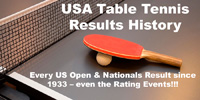August 5, 2019 - Serving Long
Serving deep has one major advantage and one major disadvantage. The advantage is that it forces an opponent to contact the ball as far from his/her target (your side of the table) as possible. The disadvantage is that it allows an opponent to attack more readily, especially with a loop drive. (Note – a short serve is a serve that, if given the chance, would bounce twice on the opponent's side of the table. Next week's Tip will be Serving Short.)
Before deciding whether to serve long or short, know the advantages of each, and match them up with both you and your opponent's strengths and weaknesses. For example, if you opponent does not attack deep serves well, and you are a strong counter-driver, you might want to serve deep topspin.
Here are four types of deep serves that are effective.
- Fast and Flat
A fast and flat serve is most effective served into an opponent's backhand. By having no spin, it "dies" when it contacts the opponent's racket, and goes into the net. Even when this serve is read properly, most players are forced to take the serve late and lift it, often setting the server up for an easy attack.Make the ball hit your side of the table as close to the endline as possible, and hit the opponent's side as deep as possible. This allows you to serve with maximum speed. It is especially important to serve this ball as deep as possible so opponent is forced to back up. Making the serve as fast and deep as possible, the opponent will have little time to make a backswing, which will make an effective return very difficult.
All serves bounce on the table twice before the opponent contacts it. Each time the ball hits the table, it picks up some topspin. If this is not taken into account, a fast and flat serve will have some topspin, and the ball won't "die" off the opponent's racket. To counteract this, stroke slightly downward at contact, putting very slight backspin on the ball.
- Deep and Spinny
Deep spin serves are among the trickiest of serves to return. The receiver not only has to read the spin but is aiming for a target farther away than for a shorter serve.A deep spin serve is slower than a fast and flat serve, so an opponent has more time to attack. You have to judge whether the serve is effective against a specific opponent.
If your spin serve breaks a lot, you might want its first bounce (on your side of the table) to be midway between the endline and the net. That way the opponent doesn't see the break for as long as possible, plus it gives a bigger angle into the receiver's backhand as it breaks sideways. You want it to land deep on the opponent's side so his/her target (your side of the table) is as far away as possible.
- Fast Down-the-Line
If you serve deep into an opponent's backhand, but he/she steps around and attacks it with a forehand, you might want to try a fast down-the-line serve. Most players who step around move too soon, so you can often get an "ace" or at a service winner. At the least, the opponent will hesitate about stepping around on the next serve. - Just off the End
Here an opponent has to decide both what type of spin is on the ball and whether the ball will go deep or not. If given the chance, the ball's second bounce (on opponent's side) would be around the edge or just off the end. This serve combines some of the advantages of a short serve and a deep spin serve. It's called a "half-long" serve.





